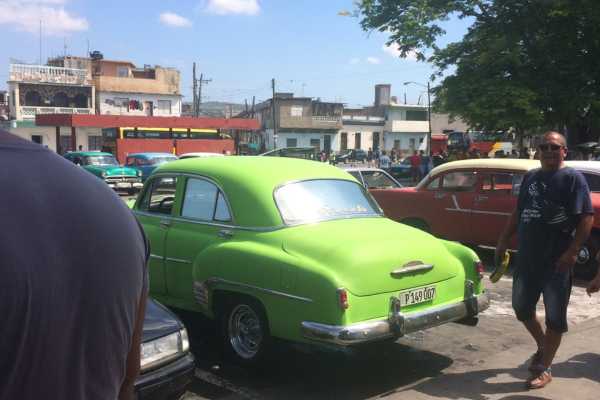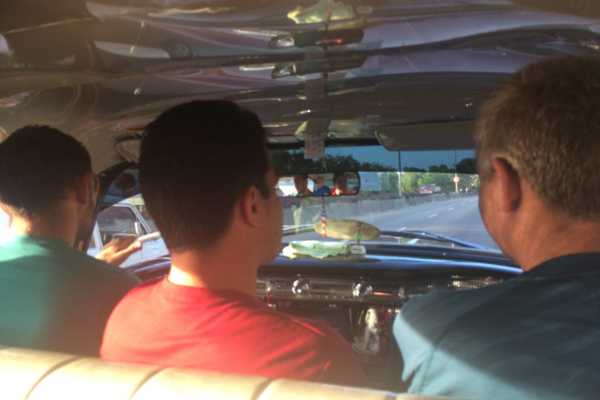It’s always a surprise for those on their first trip to Cuba, how expensive the transport can be. And how different transport in Cuba is compared to the rest of the Caribbean and the world. The transport infrastructure in Cuba is quite different from everywhere else. Years of the US embargo and mismanagement have left their mark. And while you’ll find versions of what’s called the “colectivo” around the world there’s nothing quite like a Cuban colectivo. So here’s your guide to using colectivos in Cuba.
THIS POST MAY CONTAIN COMPENSATED AND AFFILIATE LINKS. MORE INFORMATION IN OUR DISCLAIMER
Transport in Cuba can be the most expensive part of your trip, especially if you are planning to go to places in a short space of time. It’s also expensive to go to areas that aren’t covered by the standard public transport options, like the Viazul Bus or the Cuban Train System. You can read my guides here.
However, the timetables and the purchase of tickets (especially with regard to the trains) can be difficult if not downright impossible, especially if you have a limited time in Cuba.
My guide to all the transport options in Cuba is here, but today it’s all about colectivos. And how you can use them to travel around Cuba. Let’s start with the basics.
PRACTICAL TRAVEL TIPS
- 🛡️ Get Travel Insurance: Civitatis includes medical expenses, repatriation, theft, luggage delays. No deductibles or upfront payments. Get a quote here. .
- 🛂💻 Buy your Cuba eVisa here.
- 🔌 Be ready for the plug, socket & power situation.
- 📶 Internet, maps, data on the go. Buy an eSim for Cuba. Or pre-order a physical SIM card
- 🔒 Do NOT leave home without a VPN. Buy for your trip here.
What is a colectivo?
At its most very basic term, a colectivo (a collective) is a shared taxi. Colectivos usually run multiple trips per day along the same routes – from town to town or city to city. I wrote about one such experience going from Matanzas to Havana.
Colectivos aren’t as convenient as using taxis, but they’re cheaper. If you have got a lot of luggage they’re not a great idea, as you’re sharing the space with other people.

Other Names for Colectivos
Colectivo is the term for these shared vehicles that are commonly used by foreigners. You may also find them referenced, by Cubans as “Maquinas” or “Almendron”. Maquinas means machine. Almendron is a reference to almond-shaped (and refers to the shape of the vehicle). You’ll also find shared vehicles called camiones. These are converted trucks.
How do colectivos work?
The colectivos run regular routes. You pay for a seat in the car. And this “pay by seat” is important to understand especially if you are catching what you think is a taxi. You may think you’ve got a great rate for a trip if you’re quoted US$10 and you think that’s the rate for all of your party. You always need to confirm if the rate is per person, or for the car.
You won’t be able to catch a colectivo that’s going from say Santiago de Cuba to Havana. But you should be able to leapfrog along the island catching colectivos from A to B, then B to C, C to D, and so on. It won’t be quick, but it can be relatively inexpensive. And you will need time.
They don’t have set times for departure. Colectivos depart when they’re full, or when someone has paid for all the seats, or when you’ve negotiated a deal – like we did when we went from Matanzas to Havana. Colectivos have to be licensed, and as ever in Cuba its potentially complicated, and colectivos are generally licensed for Cuban passengers, not tourists. But hey, as you know, this is Cuba. They are unlikely to be stopped by the police and all the colectivo drivers will take visitors to the island, and lots of tourists and visitors will use colectivos.
Where do you catch a colectivo?
Each town and city in Cuba has a “Colectivo Terminal”. Larger cities will have multiple terminals. They’re usually located next to the bus station or train station. You know, places where people go for transport. There are a lot of standby/waitlist tickets sold in Cuba, and if you can’t get a waitlist ticket but need to get somewhere, then you still need transport. Hence the colectivo terminals.
Colectivo terminals are also found where major thoroughfares converge. So pretty much where you might take a change of direction on a route.
The easiest way to find the best place to catch a colectivo from A to B is to ask. Start with your casa particular owner. You’ll be asking “Where is the colectivo terminal to go to B”?

How much do colectivos cost?
Let’s be upfront about this. A colectivo is always going to cost you, as a foreigner, more than a Cuban. That’s for several reasons. The first is that drivers are required to have licenses, and there are different licenses, one that allows carrying foreign visitors and one that allows the carriage of Cubans.
If you speak great Spanish, then you’ll also have more chance of getting a better rate.
Some colectivos will publish a rate. Here are some January 2025 rates for colectivos in Cuba. Note that these are rates PER PERSON one way. And if you want to go to places other than a central drop-off in the city, then it will either cost more or not be possible.
- Havana to Trinidad €35 / USD$35
- Havana to Varadero €25 US$25
- Havana to Vinales €25 / US$25
- Havana to Playa Giron €30 / US$30
- Havana to Cienfuegos €20 / US$20
When do colectivos depart?
Colectivos depart when full. Or, when they’ve achieved the amount of money they want. So if seats are US$10, and there are only two of you, then you’ll be able to do a deal to get going straight away. Usually, you’ll get it a little cheaper than paying for all 4 or 5 seats, but not a huge amount. Cuban colectivo drivers are used to waiting for the vehicle to be full.
Tips for Using Colectivos
Even if you use them just once, it’s worth trying the colectivo experience. Bear in mind this guide is for the independent traveler to Cuba. If you’re reading this as a long-term resident or regular visitor no doubt it will make you smile (and I imagine you’ll also disagree with some of it – please do let me know what you’d change!)
- Don’t use colectivos if you have a lot of luggage – or you should expect to pay for using the space that your luggage uses. There may be space in the trunk, or there may not.
- Allow plenty of time for your trip. Colectivos leave when full, or when you’ve negotiated to pay for the empty spaces. It’s not uncommon to wait for 1-2 hours for the spaces to fill
- Start your journey as early in the day as possible, there’s more chance of the vehicle filling.
- Always confirm that the rate you are paying is per person. It won’t be “for the car” unless they have specifically confirmed this.
- If your Spanish isn’t great, write down the cost. Cuban Spanish is very different in pronunciation from other Spanish-speaking countries.
Frequently Asked Questions about Colectivos in Cuba
Do you have questions about Cuban colectivos? Or want to know more details about colectivos in Cuba and we haven’t answered your questions? Check out our frequently asked questions about using colectivos Cuba, or ask us yours in the comments.
Do you need to speak Spanish to use a colectivo?
It’s not necessary to speak Spanish to use a colectivo, but it will certainly make your life (and the drivers) a lot easier. You’ll need to know a few basic phrases, such as how much? Per person? And understand where you’re going.
How do you pay for colectivos?
You pay for colectivos in cash.
Can you ride in every colectivo?
No. Colectivos must be licensed by the Cuban Government and there are two types of passenger licenses issued. One that allows foreign visitors to be carried and one that’s only for Cubans. It’s not legal for a driver who has a license only for Cuban passengers to transport you in their vehicle. However, this isn’t your problem. You won’t get into trouble, but your Cuban driver might.
Can I use colectivos on the Cayos?
No, you’ll need to get a private taxi to places like Cayo Coco or Cayo Guillermo.
Can Americans use colectivos?
Colectivos tend to be operated by private individuals, not the Cuban government, and so are free from restrictions applied by the US State Department.
CUBA TRAVEL RESOURCES
CUBA BY BUS EBOOK
Buy our Ebook. Preplanned itineraries, themed routes, exact instructions for an easy visit.
Buy Cuba by Bus
BEST
CASA PARTICULARS
See choices here
Luxury rooms? Budget rooms? Laundry? Best room choice & Great hosts.
TOURS & ATTRACTIONS
Top daytrips, small group tours, tickets, pay online easily with free cancellation and top local guides.
Top options here.
TRANSFERS & TAXIS
Read my Guide
Go from A to B easily. Sightsee along the way. Maximise your time in Cuba. Book early for more options.
Final Words on Using Colectivos in Cuba
We’ve used shared taxis in many places around the world, but they’re nothing like the colectivos of Cuba. This is a truly unique experience and it’s well worth adding it to your things to do in Cuba, because traveling around Cuba, is, after all, part of the adventure of traveling here! Let me know how you get on!
Cuba’s Best is a participant in the Amazon Services LLC Associates Program, an affiliate advertising program designed to provide a means for sites to earn advertising fees by advertising and linking to amazon.com, amazon.co.uk, amazon.ca. Amazon and the Amazon logo are trademarks of Amazon.com, Inc. or its affiliates.

2 thoughts on “How to use Colectivos in Cuba”
Hi – the Viazul buses only run from Havana to Cienfuegos once a week, on a Tuesday. Does that mean that the colectivos would only run on Tuesdays, or would they also run on other days?
Hi Fiona, sorry for the delay, I’ve been on the road without internet access. Colectivos run everyday, regardless of bus timetables.